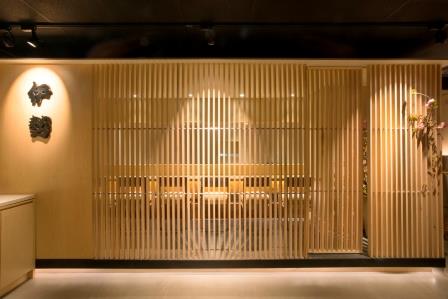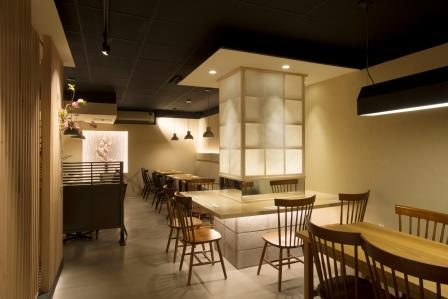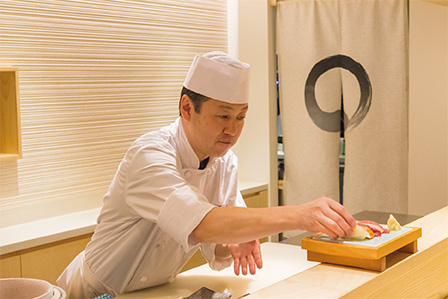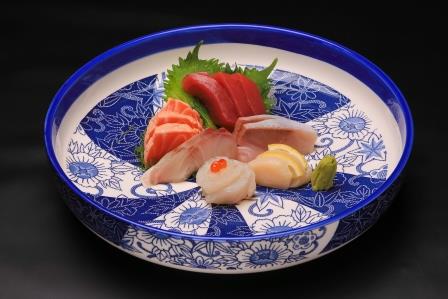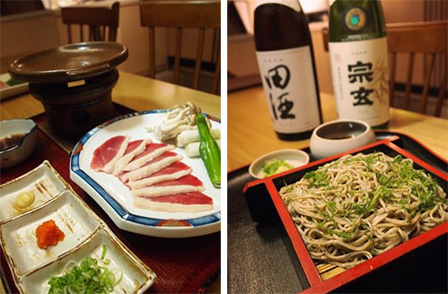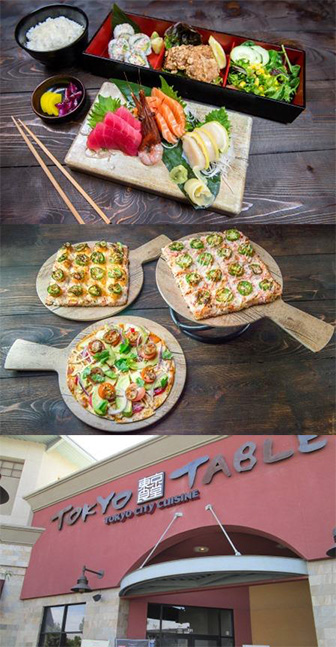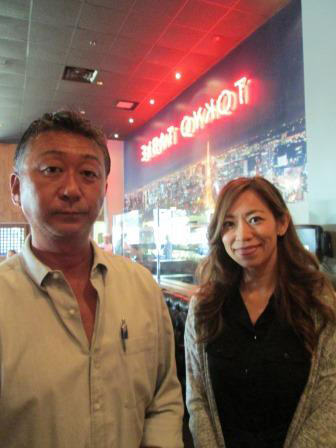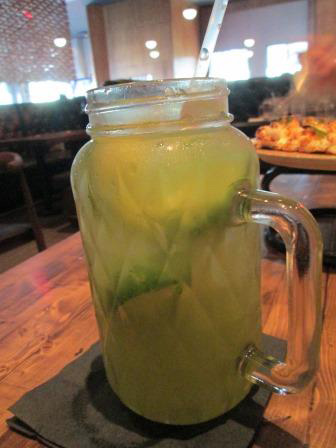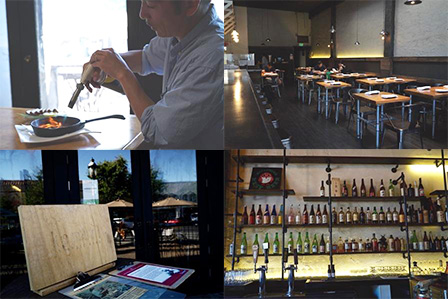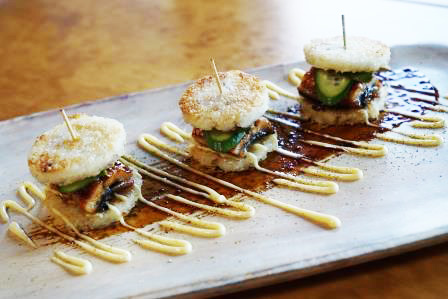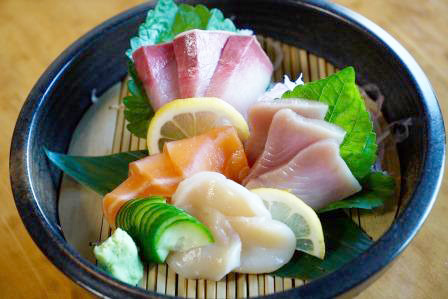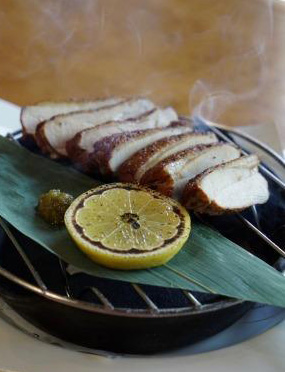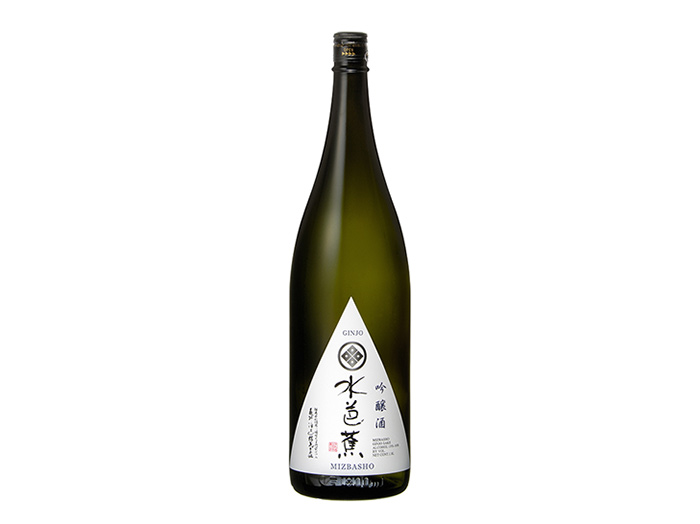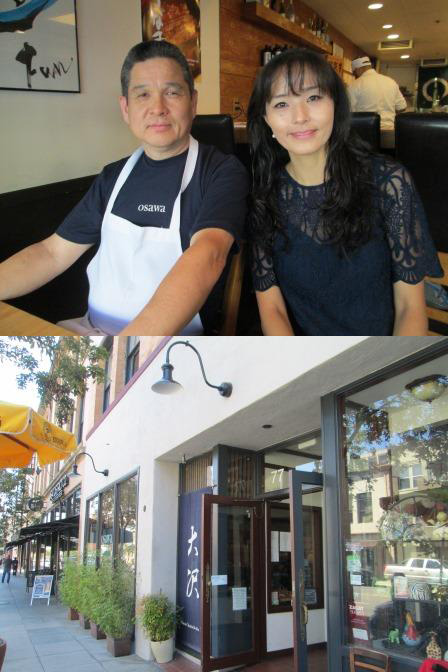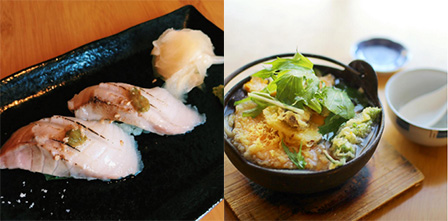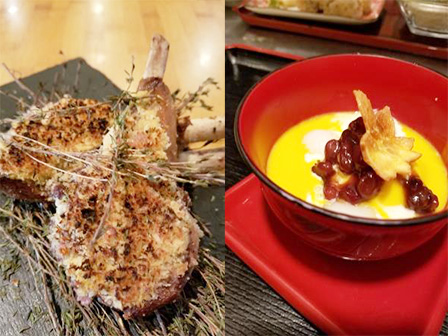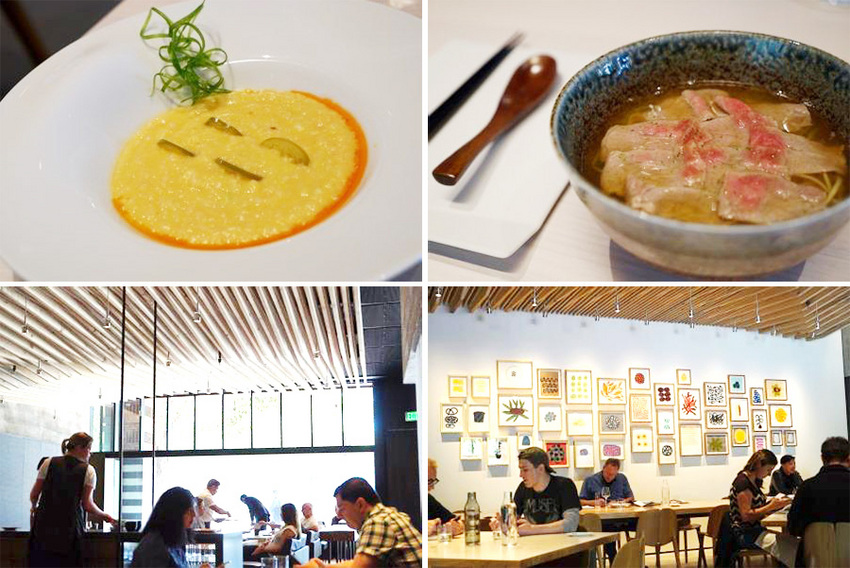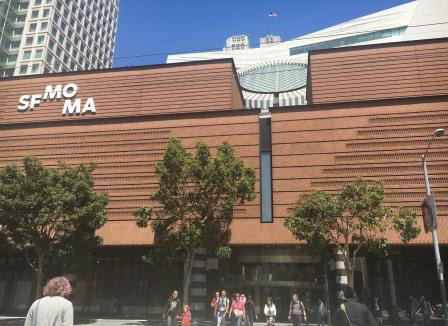“Sashimi. sushi, soba, and sake……A place where you can satisfy your palate in a sophisticated way
By Aya Ota
There is a restaurant that has a dignified appearance which makes you feel like stopping by in a corner of the busy East Village. When you step into the space as you are gravitated towards it, a noble and intense looking corridor runs before your eyes, and you feel as if you are entering another world. That is the “Ise Restaurant”, where you first taste a few slices of sashimi, and then leisurely enjoy sake with appetizers that contain various seasonal ingredients. After that, you complete the meal with sushi or soba; which is the way of a sophisticated eater. The customers in the East Village area are generally young people, and many of the dining places are casual. Among them, Ise is a rare place with a mature ambience where you can quietly enjoy meals and sake.
“Ise” is a long-lasting Japanese restaurant group which has been loved by New Yorkers for a long time since its founding in 1988. They are located in MidTown and Wall Street, and known as izakaya-style restaurants with all genres of Japanese cuisine. This time, the Wall Street location was moved to the East Village, and reborn as a new Ise with a totally brand-new concept.
“I am just doing the usual stuff,” says Masaru Makino in a plain tone, the Executive Chef. He came to the U.S. after building his career in kaiseki style cooking for 5 years in Japan. He is a veteran in this restaurant group who has been displaying his strong skills since the beginning of this group‘s history.
He says that he is just doing the usual stuff so plainly, but I know it is not at all easy to manage this so well as if he is just doing what he is supposed to do, especially at a restaurant that offers the biggest three genres of Japanese cuisine; “sashimi”, “sushi”, and “soba” as their three pillars. Actually, the true no-detail-skipping in preparation and non-compromising attitude can be felt when you taste their food. Their seafood such as blue-fin tuna, red snapper, yellow jack, firefly squid, and sea urchin come directly from Tsukiji Market in Tokyo. They pay a lot of attention to how to maintain freshness so they can always offer the freshest ingredients. It is surprising that they even manually create a special mild soy sauce to bring out the best tastes of sushi and sashimi by combining multiple soy sauce brands with mirin and bonito Flake. “Soba”, their signature menu category, which they particularly put a special effort on, is made in-house using buckwheat flour produced in the Tokachi region of Hokkaido. Its smooth, chewy and nicely firm texture is excellent, and even artistic. It cannot be tasted anywhere else. Also excellent is the dashi carefully made with 5 different kinds of dried bonitos. It is so tasty that you want to add to the soba-yu (the hot water in which the soba has been cooked, and is usually served after having a soba dish), and drink the mixture to the last drop. The twenty different sake brands displayed are carefully selected by all of the staff after actually drinking them all. The sake and the food bring out each other’s goodness, and successfully create a wonderful pairing.
“I would like the customers to enjoy our food and sake to the fullest”, continues Mr. Makino. Such thinking is represented also in the interior design. The space among the tables are luxuriously big, and some spaces are set up almost like private rooms divided effectively by plain wood latticework. The bar located near the front entrance is a beautiful space where you also may want to drop by. There, you can either have just a glass of beer, or enjoy a full menu of items just like you are sitting at a table.
Strong impressions and discovery keep coming. It appears that they are really stressing on soba dishes on the surface, but there is more. The sushi counter with only 6 seats is kind of hidden in the back of the restaurant where Mr. Makino himself prepares omakase style dishes. There is also a kaiseki course that changes monthly.
“Ise”, a newly born restaurant which makes you feel that the more often you visit, the more you feel like visiting again, and telling someone about.---It is truly the birth of a great establishment.
刺身、寿司、蕎麦、日本酒……“通”な食べ方を満喫できる店
賑やかなイーストヴィレッジの一角に、ふと足をとめたくなる凛とした佇まいの店がある。吸い寄せられるように足を踏み入れると、緊張感ある端正な造りの廊下がすっと通り、まるで別世界に入り込んでしまったかのようだ。『伊勢』
――ここでは、「まずは、刺身を数切れ、そして、四季折々の食材を取り入れた焼き物などの小料理をつまみながら、ゆっくり日本酒を楽しんだ後、寿司や蕎麦でしめる」という“通”な食べ方を満喫できる。比較的若い客層の多いイーストヴィレッジにはカジュアルな店が多い中、静かに食事と酒を楽しむことができる大人の雰囲気が漂う店だ。
『伊勢』は1988年創業以来、ニューヨーカーに永く親しまれている老舗の日本食店グループだ。ミッドタウンとウォール街に位置し、あらゆるジャンルの日本食メニューが揃う居酒屋という印象の店だが、今回、ウォール街の店舗をイーストヴィレッジへ移転、全く新しいコンセプトの『伊勢』として生まれ変わったのだ。
「ふつうのことをやっているだけ」と淡々と語るのは総料理長の牧野勝氏。同氏は、日本で5年間、懐石料理の経験を積んだ後に渡米。同グループ創業時から腕を奮ってきたベテランシェフだ。“ふつうのこと”とサラリと言うが、「刺身」「寿司」「蕎麦」の三大ジャンルを三本柱として打ち出した店で、“ふつうのこと”を当たり前のようにこなすのは決して簡単なことではない。実際、同店のメニューを口にすると、一切の手抜きをせず、妥協を許さない姿勢が伝わってくる。本マグロや真鯛、シマアジ、ホタルイカ、ウニといった魚介類は、そのほとんどを築地から直送。最善の状態で提供できるよう鮮度維持にもこだわっている。同店で使う醤油も、複数の醤油やみりん、鰹節などを使い、寿司や刺身の味を引き出すために、まろやかな醤油を手作りしているというから驚かされる。同店の看板メニューとして力を入れている蕎麦は、北海道十勝産の蕎麦粉を使い店内で手作りする。つるつるとした舌触り、しこしことした食感は、他店では味わえない見事なもので、芸術的ですらある。5種類の鰹節を活用し丁寧に作る出汁も秀逸で、そば湯を足して最後の一滴まで飲み干したい味だ。日本酒は、「スタッフ全員で試飲をして厳選した」という20種類が並んでおり、日本酒と食事がお互いの美味しさを引き出しあう、抜群の相性を醸し出している。
「料理と酒を心ゆくまでと味わってほしい」と続ける牧野氏。その気持ちは、内装にも表現されている。客席間隔は広々と贅沢にとられ、白木格子を間仕切りとして効果的に使った個室風の空間も用意されている。入り口付近に位置するバーも、ぜひ足を踏み入れたい美しい空間だ。ビール1杯だけでも気軽に楽しむこともできるし、テーブル席と変わらない食事メニューも満喫できる。
そして、同店の感動と発見はまだまだ続く。蕎麦を前面に打ち出しているかのように見えるが、実は、店内奥にひっそりと隠れるかのように、6席だけの寿司カウンターが用意されていて、牧野氏自らおまかせ寿司を提供している。また、月替わりの懐石料理コースも提供している。
足を運ぶほどに「また来たい、誰かにこの店を教えたい」と感じさせてくれる新生『伊勢』――名店の登場だ。
Ise Restaurant
63 Cooper Square, New York, NY 10003
Tel: (212) 228-4152
http://www.iserestaurantnyc.com/about-us/'rel="nofollow">website
There is a restaurant that has a dignified appearance which makes you feel like stopping by in a corner of the busy East Village. When you step into the space as you are gravitated towards it, a noble and intense looking corridor runs before your eyes, and you feel as if you are entering another world. That is the “Ise Restaurant”, where you first taste a few slices of sashimi, and then leisurely enjoy sake with appetizers that contain various seasonal ingredients. After that, you complete the meal with sushi or soba; which is the way of a sophisticated eater. The customers in the East Village area are generally young people, and many of the dining places are casual. Among them, Ise is a rare place with a mature ambience where you can quietly enjoy meals and sake.
“Ise” is a long-lasting Japanese restaurant group which has been loved by New Yorkers for a long time since its founding in 1988. They are located in MidTown and Wall Street, and known as izakaya-style restaurants with all genres of Japanese cuisine. This time, the Wall Street location was moved to the East Village, and reborn as a new Ise with a totally brand-new concept.
“I am just doing the usual stuff,” says Masaru Makino in a plain tone, the Executive Chef. He came to the U.S. after building his career in kaiseki style cooking for 5 years in Japan. He is a veteran in this restaurant group who has been displaying his strong skills since the beginning of this group‘s history.
He says that he is just doing the usual stuff so plainly, but I know it is not at all easy to manage this so well as if he is just doing what he is supposed to do, especially at a restaurant that offers the biggest three genres of Japanese cuisine; “sashimi”, “sushi”, and “soba” as their three pillars. Actually, the true no-detail-skipping in preparation and non-compromising attitude can be felt when you taste their food. Their seafood such as blue-fin tuna, red snapper, yellow jack, firefly squid, and sea urchin come directly from Tsukiji Market in Tokyo. They pay a lot of attention to how to maintain freshness so they can always offer the freshest ingredients. It is surprising that they even manually create a special mild soy sauce to bring out the best tastes of sushi and sashimi by combining multiple soy sauce brands with mirin and bonito Flake. “Soba”, their signature menu category, which they particularly put a special effort on, is made in-house using buckwheat flour produced in the Tokachi region of Hokkaido. Its smooth, chewy and nicely firm texture is excellent, and even artistic. It cannot be tasted anywhere else. Also excellent is the dashi carefully made with 5 different kinds of dried bonitos. It is so tasty that you want to add to the soba-yu (the hot water in which the soba has been cooked, and is usually served after having a soba dish), and drink the mixture to the last drop. The twenty different sake brands displayed are carefully selected by all of the staff after actually drinking them all. The sake and the food bring out each other’s goodness, and successfully create a wonderful pairing.
“I would like the customers to enjoy our food and sake to the fullest”, continues Mr. Makino. Such thinking is represented also in the interior design. The space among the tables are luxuriously big, and some spaces are set up almost like private rooms divided effectively by plain wood latticework. The bar located near the front entrance is a beautiful space where you also may want to drop by. There, you can either have just a glass of beer, or enjoy a full menu of items just like you are sitting at a table.
Strong impressions and discovery keep coming. It appears that they are really stressing on soba dishes on the surface, but there is more. The sushi counter with only 6 seats is kind of hidden in the back of the restaurant where Mr. Makino himself prepares omakase style dishes. There is also a kaiseki course that changes monthly.
“Ise”, a newly born restaurant which makes you feel that the more often you visit, the more you feel like visiting again, and telling someone about.---It is truly the birth of a great establishment.
刺身、寿司、蕎麦、日本酒……“通”な食べ方を満喫できる店
賑やかなイーストヴィレッジの一角に、ふと足をとめたくなる凛とした佇まいの店がある。吸い寄せられるように足を踏み入れると、緊張感ある端正な造りの廊下がすっと通り、まるで別世界に入り込んでしまったかのようだ。『伊勢』
――ここでは、「まずは、刺身を数切れ、そして、四季折々の食材を取り入れた焼き物などの小料理をつまみながら、ゆっくり日本酒を楽しんだ後、寿司や蕎麦でしめる」という“通”な食べ方を満喫できる。比較的若い客層の多いイーストヴィレッジにはカジュアルな店が多い中、静かに食事と酒を楽しむことができる大人の雰囲気が漂う店だ。
『伊勢』は1988年創業以来、ニューヨーカーに永く親しまれている老舗の日本食店グループだ。ミッドタウンとウォール街に位置し、あらゆるジャンルの日本食メニューが揃う居酒屋という印象の店だが、今回、ウォール街の店舗をイーストヴィレッジへ移転、全く新しいコンセプトの『伊勢』として生まれ変わったのだ。
「ふつうのことをやっているだけ」と淡々と語るのは総料理長の牧野勝氏。同氏は、日本で5年間、懐石料理の経験を積んだ後に渡米。同グループ創業時から腕を奮ってきたベテランシェフだ。“ふつうのこと”とサラリと言うが、「刺身」「寿司」「蕎麦」の三大ジャンルを三本柱として打ち出した店で、“ふつうのこと”を当たり前のようにこなすのは決して簡単なことではない。実際、同店のメニューを口にすると、一切の手抜きをせず、妥協を許さない姿勢が伝わってくる。本マグロや真鯛、シマアジ、ホタルイカ、ウニといった魚介類は、そのほとんどを築地から直送。最善の状態で提供できるよう鮮度維持にもこだわっている。同店で使う醤油も、複数の醤油やみりん、鰹節などを使い、寿司や刺身の味を引き出すために、まろやかな醤油を手作りしているというから驚かされる。同店の看板メニューとして力を入れている蕎麦は、北海道十勝産の蕎麦粉を使い店内で手作りする。つるつるとした舌触り、しこしことした食感は、他店では味わえない見事なもので、芸術的ですらある。5種類の鰹節を活用し丁寧に作る出汁も秀逸で、そば湯を足して最後の一滴まで飲み干したい味だ。日本酒は、「スタッフ全員で試飲をして厳選した」という20種類が並んでおり、日本酒と食事がお互いの美味しさを引き出しあう、抜群の相性を醸し出している。
「料理と酒を心ゆくまでと味わってほしい」と続ける牧野氏。その気持ちは、内装にも表現されている。客席間隔は広々と贅沢にとられ、白木格子を間仕切りとして効果的に使った個室風の空間も用意されている。入り口付近に位置するバーも、ぜひ足を踏み入れたい美しい空間だ。ビール1杯だけでも気軽に楽しむこともできるし、テーブル席と変わらない食事メニューも満喫できる。
そして、同店の感動と発見はまだまだ続く。蕎麦を前面に打ち出しているかのように見えるが、実は、店内奥にひっそりと隠れるかのように、6席だけの寿司カウンターが用意されていて、牧野氏自らおまかせ寿司を提供している。また、月替わりの懐石料理コースも提供している。
足を運ぶほどに「また来たい、誰かにこの店を教えたい」と感じさせてくれる新生『伊勢』――名店の登場だ。
Ise Restaurant
63 Cooper Square, New York, NY 10003
Tel: (212) 228-4152
http://www.iserestaurantnyc.com/about-us/'rel="nofollow">website







